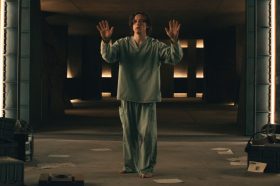Ben McCann, University of Adelaide
Jeanne Dielman, 23, quai du Commerce, 1080 Bruxelles – Chantal Akerman’s 1975 hypnotic study of a mother performing domestic chores in microscopic detail – has just been crowned the ‘greatest film of all time’ in Sight and Sound’s recent poll.
It is only the fourth film to have topped the list since polling began, and the first directed by a woman.
The full list of 100 films was published last week, with the top ten:
- Jeanne Dielman, 23, quai du Commerce, 1080 Bruxelles (Chantal Akerman, 1975)
- Vertigo (Alfred Hitchcock, 1958)
- Citizen Kane (Orson Welles, 1941)
- Tokyo Story (Yasujiro Ozu, 1953)
- In the Mood for Love (Wong Kar-wai, 2000)
- 2001: A Space Odyssey (Stanley Kubrick, 1968)
- Beau Travail (Claire Denis, 1999)
- Mulholland Drive (David Lynch, 2001)
- Man with a Movie Camera (Dziga Vertov, 1929)
- Singin’ in the Rain (Stanley Donen and Gene Kelly, 1952)
If you are looking for a crash-course in film history, this is not a bad place to start.
How did we get here?
Once a decade since 1952, the British Film Institute’s magazine Sight and Sound has polled filmmakers, critics, curators and programmers from around the world, asking them to name their ten best films ever made.
In the film world, this is the list that counts.
It is collated by the industry itself, its rankings are a barometer of changing movie-going tastes, and the ten-year wait between each announcement cements its reputation.
Polling began in June this year and everyone is sworn to secrecy. Mike Williams, the editor of Sight and Sound, has spoken about the magazine’s ‘credibility, authority, and an international reputation that’s second to none’.
The first winner in 1952 was Vittorio de Sica’s Bicycle Thieves (1948), the masterpiece of Italian neorealism. In the five polls from 1962 to 2002, the winner remained the same: Citizen Kane, Orson Welles’ 1941 debut.
Kane’s status as the ‘greatest’ was consistently reinforced by directors and critics who admired Welles’ authorial single-mindedness, his chutzpah and his daring dismantling of Hollywood’s rules about storytelling and visual composition.
Citizen Kane was finally dethroned in 2012 by Vertigo, Alfred Hitchcock’s 1958 twisted tale of obsession and betrayal.
Vertigo’s gradual rise up the list (it first appeared in 1982, and finished only 34 votes behind Kane in 2002) reflected cinema’s ongoing recognition of Hitchcock as an artist. As the critic Roger Ebert wrote at the time, ‘The king is dead. Long live the king’.
As a film historian, it is fascinating to track the performances of some of cinema’s most beloved and esteemed films.
Casablanca (1942), The Wizard of Oz (1939), Gone With the Wind (1939) and It’s A Wonderful Life (1946) – for some, the apex of Hollywood’s expertise – have never made it anywhere near the top of the list.
The poll’s reluctance to embrace popular genres like musicals, comedies and westerns is reflected in the fact that only Singin’ in the Rain (1952), The General (1926) and The Searchers (1956) have ever appeared in the top ten. https://www.youtube.com/embed/KYkL518Knm0?wmode=transparent&start=0
But Hollywood has never dominated the list. To Sight and Sound’s credit, this is a global poll, with voices, opinions and perspectives canvassed from across the world cinema ecosystem. In 2012, a total of 2,045 different films received at least one mention.
The list is always eclectic and international. The Rules of the Game (1939, France) has appeared in every poll until this year, along with the likes
So what does the new poll tell us?
In 2022, there are more contributors than ever before – 1,600 industry insiders, up from 846 back in 2012.
Apart from the new winner, this broader church has not shifted the results in any meaningful way. Vertigo, Citizen Kane and Tokyo Story are still ranked two, three and four.
But a generational shift is taking place. New critics have emerged over the past decade and this is reflected in their choices: the masterpieces by Wong Kar-Wai, Kubrick and Lynch have all moved up in the rankings.
The new poll has also skewed towards ‘newer’ films for the first time. In 2012, there were no films on the list made in the preceding decade. This year’s list includes Portrait of a Lady on Fire (2019), Moonlight (2016), Parasite (2019) and Get Out (2017), alongside other relatively new additions The Gleaners and I (2000), Spirited Away (2001) and Tropical Malady (2004).
What is even more exciting is a direct challenge to what might be seen as the film industry’s herd mentality.
For years, the same films have been reconfirmed as the only ones worth talking about. The 2022 poll smashes open this echo chamber, recognising not just Akerman, but also Claire Denis, whose majestic Beau Travail (1999) makes its first appearance at number seven and Agnès Varda’s Cléo from 5 to 7 (1962) at 14.
Francophone female directors, it seems, are currently at the vanguard of great cinema.
But what will happen in 2032? Will Jeanne Dielman stand the test of time? Is there a film that hasn’t been made yet that will make an appearance in the top ten? Unlikely, given that there is usually at least a 20-year lag between a film’s release and its appearance on the list.
With this year’s list, we learned it takes time for a film to enter the critical consciousness and to reveal its stylistic intricacies or narrative pleasures.
We have just been reminded that the classics will always appear on polls and lists because, well, they are classic. They display craft, precision, elegance and emotional depth. They resonate down the decades, and they are the films that many of us – from world-famous directors to armchair critics – turn to again and again.
In the meantime, go and watch Jeanne Dielman, 23, quai du Commerce, 1080 Bruxelles and see what all the fuss is about.
Ben McCann, Associate Professor of French Studies, University of Adelaide
This article is republished from The Conversation under a Creative Commons license. Read the original article.





